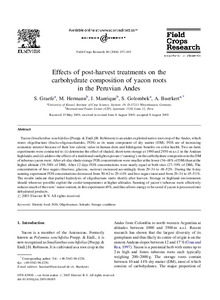Effects of post-harvest treatments on the carbohydrate composition of yacon roots in the Peruvian Andes
| dc.date.accessioned | 2007-05-14T12:14:16Z | |
| dc.date.available | 2007-05-14T12:14:16Z | |
| dc.date.issued | 2004 | |
| dc.identifier.issn | 0378-4290 | |
| dc.identifier.uri | urn:nbn:de:hebis:34-2007051418189 | |
| dc.identifier.uri | http://hdl.handle.net/123456789/2007051418189 | |
| dc.format.extent | 122970 bytes | |
| dc.format.mimetype | application/pdf | |
| dc.language.iso | eng | |
| dc.rights | Urheberrechtlich geschützt | |
| dc.rights.uri | https://rightsstatements.org/page/InC/1.0/ | |
| dc.subject | Dietetic food | eng |
| dc.subject | FOS | eng |
| dc.subject | Oligofructans | eng |
| dc.subject | Soleado | eng |
| dc.subject | Storage conditions | eng |
| dc.subject.ddc | 630 | |
| dc.title | Effects of post-harvest treatments on the carbohydrate composition of yacon roots in the Peruvian Andes | eng |
| dc.type | Aufsatz | |
| dcterms.abstract | Yacon (Smallanthus sonchifolius [Poepp. & Endl.] H. Robinson) is an under-exploited native root crop of the Andes, which stores oligofructans (fructo-oligosaccharides, FOS) as its main component of dry matter (DM). FOS are of increasing economic interest because of their low caloric value in human diets and bifidogenic benefits on colon health. Two on-farm experiments were conducted to: (i) determine the effect of shaded, short-term storage at 1990 and 2930 m a.s.l. in the Andean highlands; and (ii) address the effects of a traditional sunlight exposure (‘sunning’) on the carbohydrate composition in the DM of tuberous yacon roots. After a 6-day shade storage FOS concentrations were smaller at the lower (36–48% of DM) than at the higher altitude (39–58% of DM). After 12 days FOS concentrations were nearly equal at both sites (27–39% of DM). The concentration of free sugars (fructose, glucose, sucrose) increased accordingly from 29–34 to 48–52%. During the 6-day sunning experiment FOS concentrations decreased from 50–62 to 29–44% and free sugars increased from 29–34 to 45–51%. The results indicate that partial hydrolysis of oligofructans starts shortly after harvest. Storage in highland environments should wherever possible exploit the cooler temperatures at higher altitudes. Sunning of yacon’s tuberous roots effectively reduces much of the roots’ water content, in this experiment 40%, and thus allows energy to be saved if yacon is processed into dehydrated products. | eng |
| dcterms.accessRights | open access | |
| dcterms.bibliographicCitation | In: Field crops research. Amsterdam : Elsevier. 86.2004, H. 2, S. 157-165 | |
| dcterms.creator | Graefe, Sophie | |
| dcterms.creator | Hermann, M. | |
| dcterms.creator | Manrique, I. | |
| dcterms.creator | Golombek, S. | |
| dcterms.creator | Bürkert, Andreas | |
| dc.description.everything | The original publication is available at www.elsevier.com | eng |
Files in this item
This item appears in the following Collection(s)
-
Publikationen [36]

